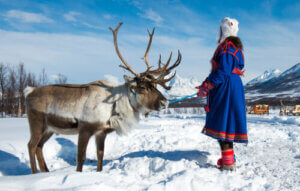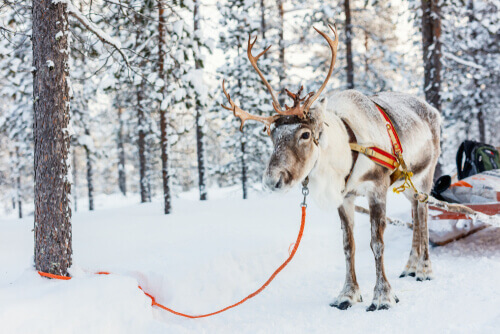The Sami: The Last Reindeer Herders


Written and verified by the vet Eugenio Fernández Suárez
The Sami are a northern European people known for being the last reindeer herders. Each year, the Sami keep an eye on the sky to see when it’s time to start the long journey with their hundreds of reindeer.
The last reindeer herders
These reindeer herders were among the first people to become aware of climate change. And as early as the late 1980s, they began to change their herding practices to cope with it. They’ve always been a people with a great ability to adapt.
The Sami own hundreds of thousands of reindeer. And, although they’ve adapted to the European way of life, they’re also the last indigenous people in Europe. In fact, there are 100,000 natives spread across Norway, Sweden, Finland, and even Russia.
Reindeer herders in the 21st century
Hunting, fishing, and herding are still the main activities of a people that occupies 40% of Norway. Their transhumance route crosses several countries with borders, something that seems to bother the European authorities.
The economic contribution of the Sami people is marginal. However, the fact is that, together with other ethnic groups across the globe, they’ve been the guardians of the Arctic for decades.

Meet the reindeer
It’s difficult to talk about the Sami without talking about reindeer. Although the Sami people have gone from living in villages to living in conventional houses, many of their customs haven’t changed. And that includes their work as reindeer herders.
The Sami still herd reindeer, that hoofed mammal that lives in the tundra and taiga of the northern hemisphere and is made up of numerous subspecies.
Although it’s still a wild animal, the fact is that the Sami were able to domesticate this species thanks to mass reindeer herding, which took place between the 16th and 18th centuries.
In Sweden, Finland, and Norway, practically all reindeer have Sami owners, who are in charge of transhumance migrations with them. In contrast, reindeer in Greenland, Iceland, and North America are wild.

Reindeer herders and climate change
Although reindeer herders seem willing to adapt to the changes, there are animals that aren’t so quick to adapt. Between 2013 and 2014, 30,000 reindeer died in the Yamal peninsula due to frost. That was half of the population living in this area of Russia.
For example, many of the reindeer herding routes used by the Sami were based on crossing large sheets of ice, which is becoming brittle and unsafe.
Meanwhile, the tundra ecosystem to which the Sami are linked is receding year by year, and moving further north, along with the plant and animal species they coexist with.
Governments, the danger to reindeer herders
The Sami, however, are more afraid of governments, which are creating more and more infrastructure to block their activities, increasing forest clearance, and changing land use without consulting the Sami people.
This is because the poles are becoming more accessible and, therefore, easier to exploit, and extractive industries are pushing the Sami and their former grazing lands into a corner.
Nevertheless, the Sami have hope as long as they’re allowed to own the destiny of their land and are given free access to the territories to adapt their grazing to the changing climate.
The Sami are a northern European people known for being the last reindeer herders. Each year, the Sami keep an eye on the sky to see when it’s time to start the long journey with their hundreds of reindeer.
The last reindeer herders
These reindeer herders were among the first people to become aware of climate change. And as early as the late 1980s, they began to change their herding practices to cope with it. They’ve always been a people with a great ability to adapt.
The Sami own hundreds of thousands of reindeer. And, although they’ve adapted to the European way of life, they’re also the last indigenous people in Europe. In fact, there are 100,000 natives spread across Norway, Sweden, Finland, and even Russia.
Reindeer herders in the 21st century
Hunting, fishing, and herding are still the main activities of a people that occupies 40% of Norway. Their transhumance route crosses several countries with borders, something that seems to bother the European authorities.
The economic contribution of the Sami people is marginal. However, the fact is that, together with other ethnic groups across the globe, they’ve been the guardians of the Arctic for decades.

Meet the reindeer
It’s difficult to talk about the Sami without talking about reindeer. Although the Sami people have gone from living in villages to living in conventional houses, many of their customs haven’t changed. And that includes their work as reindeer herders.
The Sami still herd reindeer, that hoofed mammal that lives in the tundra and taiga of the northern hemisphere and is made up of numerous subspecies.
Although it’s still a wild animal, the fact is that the Sami were able to domesticate this species thanks to mass reindeer herding, which took place between the 16th and 18th centuries.
In Sweden, Finland, and Norway, practically all reindeer have Sami owners, who are in charge of transhumance migrations with them. In contrast, reindeer in Greenland, Iceland, and North America are wild.

Reindeer herders and climate change
Although reindeer herders seem willing to adapt to the changes, there are animals that aren’t so quick to adapt. Between 2013 and 2014, 30,000 reindeer died in the Yamal peninsula due to frost. That was half of the population living in this area of Russia.
For example, many of the reindeer herding routes used by the Sami were based on crossing large sheets of ice, which is becoming brittle and unsafe.
Meanwhile, the tundra ecosystem to which the Sami are linked is receding year by year, and moving further north, along with the plant and animal species they coexist with.
Governments, the danger to reindeer herders
The Sami, however, are more afraid of governments, which are creating more and more infrastructure to block their activities, increasing forest clearance, and changing land use without consulting the Sami people.
This is because the poles are becoming more accessible and, therefore, easier to exploit, and extractive industries are pushing the Sami and their former grazing lands into a corner.
Nevertheless, the Sami have hope as long as they’re allowed to own the destiny of their land and are given free access to the territories to adapt their grazing to the changing climate.
This text is provided for informational purposes only and does not replace consultation with a professional. If in doubt, consult your specialist.








